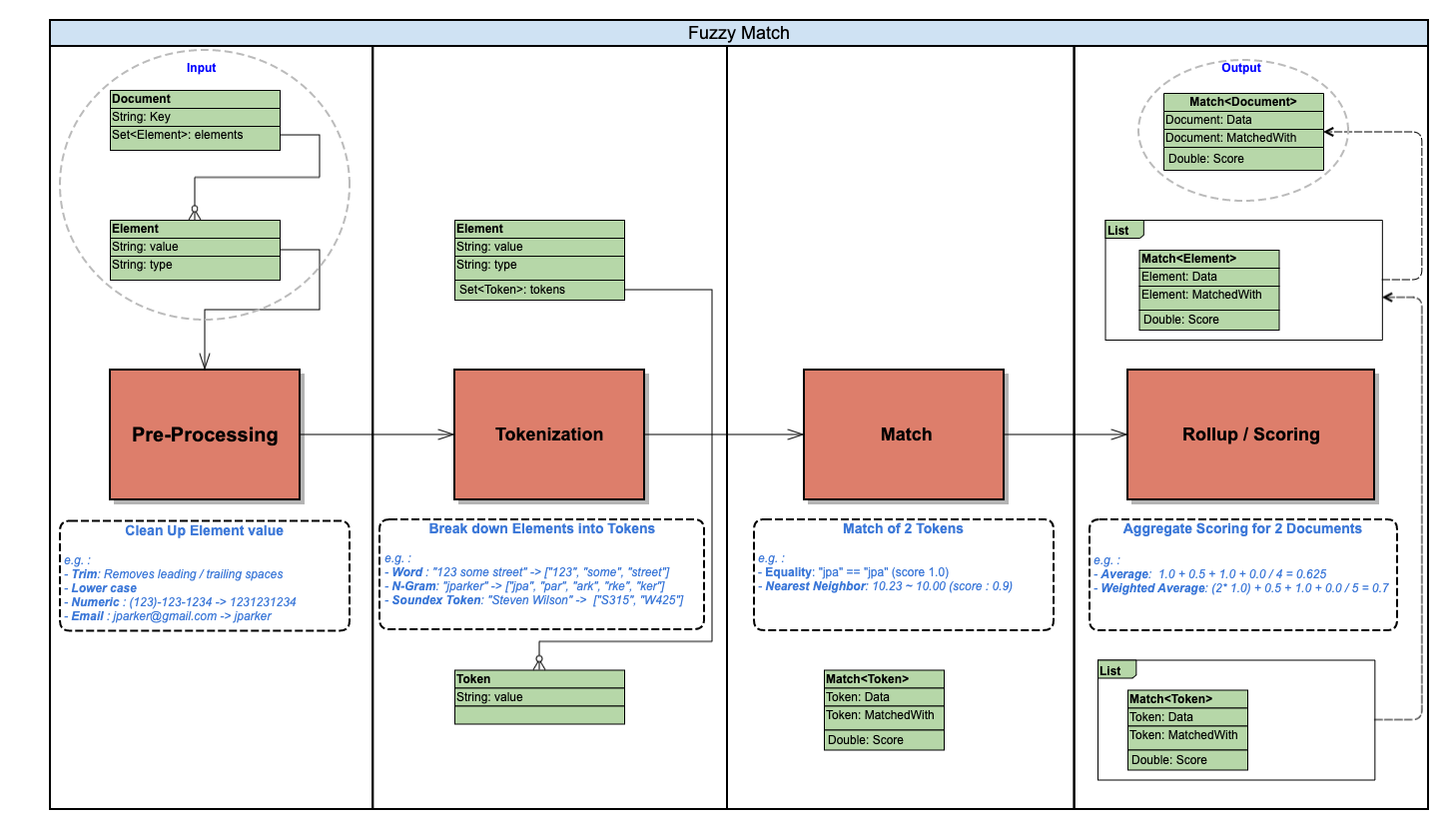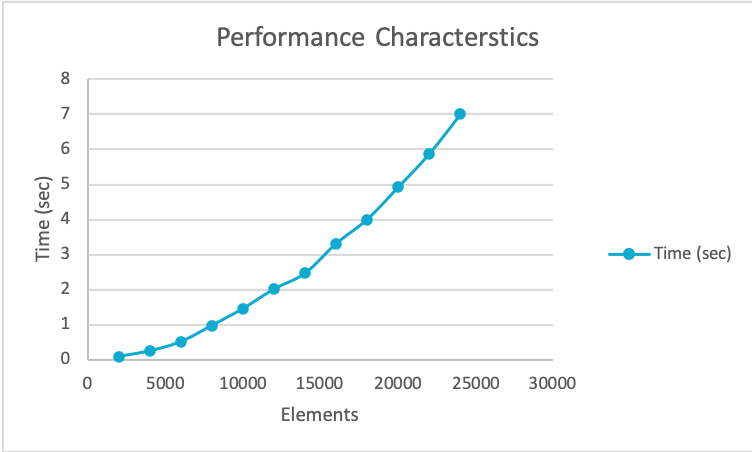A java-based library to match and group "similar" elements in a collection of documents.
Imagine working in a system with a collection of contacts and wanting to match and categorize contacts with similar names, addresses or other attributes. The Fuzzy Match matching algorithm can help you do this. The Fuzzy Match algorithm can even help you find duplicate contacts, or prevent your system from adding duplicates.
This library can act on any domain object, like contact, and find similarity for various use cases. It dives deep into each character and finds out the probability that 2 or more objects are similar.
The contacts "Steven Wilson" living at "45th Avenue 5th st." and "Stephen Wilkson" living at "45th Ave 5th Street"
might look like belonging to the same person. It's easy for humans to ignore the small variance in spelling in names,
or ignore abbreviation used in address. But for a computer program they are not the same. The string Steven does not
equals Stephen and neither does Street equals st.
If our trusted computers can start looking at each character and the sequence in which they appear, it might look similar.
Fuzzy matching algorithms is all about providing this level of magnification to our myopic machines.
This algorithm accepts data in a list of entities called Document (like a contact entity in your system), which can contain 1
or more Element (like names, address, emails, etc). Internally each element is further broken down into 1 or more Token
which are then matched using configurable MatchType
This combination to tokenize the data and then to match them can extract similarity in a wide variety of data types
Consider these Elements defined in two different Documents
- Wayne Grace Jr.
- Grace Hilton Wayne
With a simple tokenization process each word here can be considered a token, and if another element has the same word
they are scored on the number of matching tokens. In this example the words Wayne and Grace match 2 words out of
3 total in each elements. A scoring mechanism will match them with a result of 0.67
Consider these Elements in two different Documents
- Steven Wilson
- Stephen Wilkson
Here we do not just look at each word, but encode it using Soundex which gives a unique code for the phonetic spelling of the name.
So in this example words Steven & Stephen will encode to S315 whereas the words Wilson & Wilkson encode to W425.
This allows both the elements to match exactly, and score at 1.0
In cases where breaking down the Elements in words is not feasible, we split it using NGrams. Take for examples emails
Here if we ignore the domain name and take 3 character sequence (tri-gram) of the data, tokens will look like this
- parker.james -> [par, ark, rke, ker, er., r.j, .ja, jam, ame, mes]
- james_parker -> [jam, ame, mes, es_, s_p, _pa, par, ark, rke, ker]
Comparing these NGrams we have 7 out of the total 10 tokens match exactly which gives a score of 0.7
In certain cases breaking down elements into tokens and comparing tokens is not an option. For example numeric values, like dollar amounts in a list of transactions
- 100.54
- 200.00
- 100.00
Here the first and third could belong to the same transaction, where the third is only missing some precession. The match is done not on tokens being equal but on the closeness (the neighborhood range) in which the values appear. This closeness is again configurable where a 99% closeness, will match them with a score of 1.0
A similar example can be thought of with Dates, where dates that are near to each other might point to the same event.
We spoke in detail on Token and MatchType which is the core of fuzzy matching, and touched upon Scoring which gives
the measure of matching similar data. PreProcessing your data is a simple yet powerful mechanism that can help in starting
with clean data before running a match. These 4 stages which are highly customizable can be used to tune and match a wide variety of data types
-
Pre-Processing : This accepts a java
Function. Which allows you to externally develop the pre-processing functionality and pass it to the library. Or use some of the existing ones. These are a few examples that are already available- Trim: Removes leading and trailing spaces (applied by default)
- Lower Case: Converts all characters to lowercase (applied by default)
- Remove Special Chars : Removes all characters except alpha and numeric characters and spaces. (default for TEXT type)
- Numeric: Strips all non-numeric characters. Useful for numeric values like phone or ssn (default for NUMBER type)
- Email: Strips away domain from an email. This prevents common domains like gmail.com, yahoo.com to be considered in match (default for EMAIL type)
-
Tokenization : This again accepts a
Functionso can be externally defined and fed to the library. Some commonly used are already available.- Word : Breaks down an element into words (anything delimited by space " ").
- N-Gram : Breaks down an element into 3 letter grams.
- Word-Soundex : Breaks down in words (space delimited) and gets Soundex encode using the Apache Soundex library
- Value : Nothing to break down here, just uses the element value as token. Useful for Nearest Neighbor matches
-
Match Type : Allows 2 types of matches, which can be applied to each
Element- Equality: Uses exact matches with token values.
- Nearest Neighbor: Finds tokens that are contained in the neighborhood range, that can be specified as a probability (0.0 - 1.0) for each element. It defaults to 0.9
-
Scoring : These are defined for
ElementandDocumentmatches- Element scoring: Uses a simple average, where for each element the matching token is divided by the total tokens.
A configurable
thresholdcan be set for each element beyond which elements are considered to match (default set at 0.3) - Document scoring: A similar approach where number of matching elements are compared with total element.
In addition, each element can be give a
weight. This is useful when some elements in a document are considered more significant than others. Athresholdcan also be specified at a document level (defaults to 0.5) beyond which documents are considered to match
- Element scoring: Uses a simple average, where for each element the matching token is divided by the total tokens.
A configurable
All the configurable options defined above can be applied at various points in the library.
Below is the list of predefined Element Types available with sensible defaults. These can be overridden by setters while creating an Element.
| Element Type | PreProcessing Function | Tokenizer Function | Match Type |
|---|---|---|---|
| NAME | namePreprocessing() | wordSoundexEncodeTokenizer() | EQUALITY |
| TEXT | removeSpecialChars() | wordTokenizer() | EQUALITY |
| ADDRESS | addressPreprocessing() | wordSoundexEncodeTokenizer() | EQUALITY |
| removeDomain() | triGramTokenizer() | EQUALITY | |
| PHONE | numericValue() | decaGramTokenizer() | EQUALITY |
| NUMBER | numberPreprocessing() | valueTokenizer() | NEAREST_NEIGHBORS |
| DATE | none() | valueTokenizer() | NEAREST_NEIGHBORS |
| AGE | numberPreprocessing() | valueTokenizer() | NEAREST_NEIGHBORS |
Note: Since each element is unique in the way it should match, if you need to match a different element type than what is supported, please open a new GitHub Issue and the community will provide support and enhancement to this library
- Key: Required field indicating unique primary key of the document
- Elements: Set of elements for each document
- Threshold: A double value between 0.0 - 1.0, above which the document is considered as match.
- Value : String representation of the value to match
- Type : These are predefined elements, which apply relevant functions for "PreProcessing", "Tokenization" and "MatchType"
- Variance: (Optional) To differentiate same element types in a document. eg. a document containing 2 NAME element one for "user" and one for "spouse"
- Threshold: A double value between 0.0 - 1.0, above which the element is considered as match.
- Weight: A value applied to an element to increase or decrease the document score. The default is 1.0, any value above that will increase the document score if that element is matched.
- PreProcessingFunction: Override The PreProcessingFunction function defined by Type
- TokenizerFunction: Override The TokenizerFunction function defined by Type
- MatchType: Override the MatchType defined by Type
- NeighborhoodRange: Relevant only for
NEAREST_NEIGHBORSMatchType. Defines how close should theValuebe, to be considered a match. Accepted values between 0.0 - 1.0 (defaults to 0.9)
It supports 3 ways to match the documents
- Match a list of Documents: This is useful if you have an existing list of documents, and want to find out which of them might have potential duplicates. A typical de-dup use case
matchService.applyMatchByDocId(List<Document> documents)
- Match a list of Documents with an Existing List: This is useful for matching a new list of documents with an existing list in your system. For example, if you're performing a bulk import and want to find out if any of them match with existing data
matchService.applyMatchByDocId(List<Document> documents, List<Document> matchWith)
- Match a Document with Existing List: This is useful when a new document is being created and you want to ensure that a similar document does not already exist in your system
matchService.applyMatchByDocId(Document document, List<Document> matchWith)
The response of the library is essentially a Match<Document> object. It has 3 attributes
- Data: This is the source Document on which the match is applied
- MatchedWith: This is the target Document that the data matched with
- Result: This is the probability score between 0.0 - 1.0 indicating how similar the 2 documents are
The response is grouped by the Data.key, so from any of the MatchService methods the response is map
Map<String, List<Match<Document>>>
The library is published to maven central
<dependency>
<groupId>com.intuit.fuzzymatcher</groupId>
<artifactId>fuzzy-matcher</artifactId>
<version>1.2.0</version>
</dependency>
(Note: This requires java 11. For java 8 use version 1.1.x)
This library takes a collection of Document objects with various Elements as input.
For example, if you have a multiple contacts as a simple String Arrays
String[][] input = {
{"1", "Steven Wilson", "45th Avenue 5th st."},
{"2", "John Doe", "546 freeman ave"},
{"3", "Stephen Wilkson", "45th Ave 5th Street"}
};
Convert them into List of Document
List<Document> documentList = Arrays.asList(input).stream().map(contact -> {
return new Document.Builder(contact[0])
.addElement(new Element.Builder<String>().setValue(contact[1]).setType(NAME).createElement())
.addElement(new Element.Builder<String>().setValue(contact[2]).setType(ADDRESS).createElement())
.createDocument();
}).collect(Collectors.toList());
The entry point for running this program is through MatchService class. Create a new instance of Match service, and use applyMatch methods to find matches
MatchService matchService = new MatchService();
Map<String, List<Match<Document>>> result = matchService.applyMatchByDocId(documentList);
This prints the result to console. This should show a match between the 1st and 3rd document, but not the 2nd.
result.entrySet().forEach(entry -> {
entry.getValue().forEach(match -> {
System.out.println("Data: " + match.getData() + " Matched With: " + match.getMatchedWith() + " Score: " + match.getScore().getResult());
});
});
For most real life data-sets, the size of the data I am sure is not as simple as shown in the examples.
Since this library can be used to match elements against a large set of records, knowing how it performs is essential.
The performance characteristics varies primarily on MatchType being used
-
EQUALITY - For equality match, which is the default for most Element Types, the performance is linear O(N). Where N is the number of
Elementin all the document. -
NEAREST_NEIGHBOR - The default for Numeric and Date Element Types the performance is O(N logN). This also depends on the
NeighborhoodRangesetting , the higher the value the better it will perform. It is advisable to not use 1.0 as aNeighborhoodRangeand instead over-ride theMatchTypeto beEQUALITY, that way it guarantees a linear performance.
The following chart shows the performance characteristics of this library as the number of elements increase. As you can see, the library maintains a near-linear performance and can match thousands of elements within seconds on a multi-core processor.

